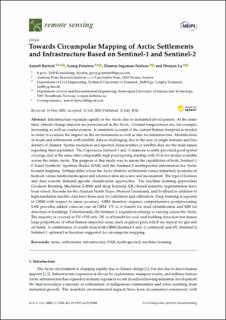| dc.contributor.author | Bartsch, Annett | |
| dc.contributor.author | Pointner, Georg | |
| dc.contributor.author | Ingeman-Nielsen, Thomas | |
| dc.contributor.author | Lu, Wenjun | |
| dc.date.accessioned | 2022-05-10T07:33:37Z | |
| dc.date.available | 2022-05-10T07:33:37Z | |
| dc.date.created | 2020-08-05T11:33:09Z | |
| dc.date.issued | 2020 | |
| dc.identifier.citation | Remote Sensing. 2020, 12 (15), . | en_US |
| dc.identifier.issn | 2072-4292 | |
| dc.identifier.uri | https://hdl.handle.net/11250/2994937 | |
| dc.description.abstract | Infrastructure expands rapidly in the Arctic due to industrial development. At the same time, climate change impacts are pronounced in the Arctic. Ground temperatures are, for example, increasing as well as coastal erosion. A consistent account of the current human footprint is needed in order to evaluate the impact on the environments as well as risk for infrastructure. Identification of roads and settlements with satellite data is challenging due to the size of single features and low density of clusters. Spatial resolution and spectral characteristics of satellite data are the main issues regarding their separation. The Copernicus Sentinel-1 and -2 missions recently provided good spatial coverage and at the same time comparably high pixel spacing starting with 10 m for modes available across the entire Arctic. The purpose of this study was to assess the capabilities of both, Sentinel-1 C-band Synthetic Aperture Radar (SAR) and the Sentinel-2 multispectral information for Arctic focused mapping. Settings differ across the Arctic (historic settlements versus industrial, locations on bedrock versus tundra landscapes) and reference data are scarce and inconsistent. The type of features and data scarcity demand specific classification approaches. The machine learning approaches Gradient Boosting Machines (GBM) and deep learning (DL)-based semantic segmentation have been tested. Records for the Alaskan North Slope, Western Greenland, and Svalbard in addition to high-resolution satellite data have been used for validation and calibration. Deep learning is superior to GBM with respect to users accuracy. GBM therefore requires comprehensive postprocessing. SAR provides added value in case of GBM. VV is of benefit for road identification and HH for detection of buildings. Unfortunately, the Sentinel-1 acquisition strategy is varying across the Arctic. The majority is covered in VV+VH only. DL is of benefit for road and building detection but misses large proportions of other human-impacted areas, such as gravel pads which are typical for gas and oil fields. A combination of results from both GBM (Sentinel-1 and -2 combined) and DL (Sentinel-2; Sentinel-1 optional) is therefore suggested for circumpolar mapping. View Full-Text | en_US |
| dc.language.iso | eng | en_US |
| dc.publisher | MDPI | en_US |
| dc.rights | Navngivelse 4.0 Internasjonal | * |
| dc.rights.uri | http://creativecommons.org/licenses/by/4.0/deed.no | * |
| dc.title | Towards Circumpolar Mapping of Arctic Settlements and Infrastructure Based on Sentinel-1 and Sentinel-2 | en_US |
| dc.title.alternative | Towards Circumpolar Mapping of Arctic Settlements and Infrastructure Based on Sentinel-1 and Sentinel-2 | en_US |
| dc.type | Peer reviewed | en_US |
| dc.type | Journal article | en_US |
| dc.description.version | publishedVersion | en_US |
| dc.source.pagenumber | 28 | en_US |
| dc.source.volume | 12 | en_US |
| dc.source.journal | Remote Sensing | en_US |
| dc.source.issue | 15 | en_US |
| dc.identifier.doi | 10.3390/rs12152368 | |
| dc.identifier.cristin | 1821740 | |
| cristin.ispublished | true | |
| cristin.fulltext | original | |
| cristin.qualitycode | 1 | |

